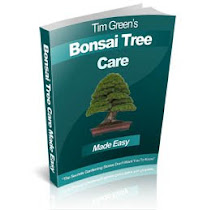Welcome back to Indoor Bonsai for Beginners!
Today we are going to talk about the different types (or styles) of bonsai trees.
I know - I know....I've told you the bonsai tools you need to purchase and we decided which bonsai starter tree we are picking. So..why all this history? Simply because knowledge is power. The more you know about bonsai history the better bonsai-master you will become. Yes - I said bonsai-MASTER. After all - it's our goal to give you all the tools you need to create and maintain a wide variety of indoor bonsai.
Types of Indoor Bonsai (Styles)
After looking at many different types of bonsai trees you will notice that there are many unique trees. However, they have certain elements in common. These can be defined in the types of bonsai (or styles of bonsai). FORMAL UPRIGHT
FORMAL UPRIGHT
Formal Upright bonsai are known for their perfectly straight trunks which are wide at the base and taper uniformly to the top of the tree. The branches all should be the same length giving you a symmetrical look when viewed from any angle. Formal upright bonsai represent what a tree would look like if it were grown in ideal conditions. This is why the formal upright bonsai is the most difficult style to master. INFORMAL UPRIGHT
INFORMAL UPRIGHT
Informal Upright bonsai the trunk slightly bends. Unlike the formal upright, this type of bonsai appears to be bending either due to wind or leaning towards the sun. Branches are much less uniform. This tree represents what a tree would look like if it had experienced harsh elements in it's early formative years. SLANT STYLE
SLANT STYLE
Slant Style trees are identified by their angular trunks. There is a definite slope to the trunk as if sustained wind had caused the tree to bend permanently. Similarly, the branch structure is heavily weighted to the side the tree is leaning.  SEMI-CASCADE STYLE
SEMI-CASCADE STYLE
The Semi-Cascade Style is similar to the Cascade Style except for the fact that the branches to extend past the bonsai pot but do not dip below it. It is what one would see on the side of a cliff. A very unique style which is much easier to achieve. CASCADE STYLE
CASCADE STYLE
The Cascade Style can be identified by it's branches that dip below the bonsai pot. It's almost as if gravity is coaxing the tree downward. This style is one of the easier styles to achieve.
Knowing these types of bonsai will help you pick out your first indoor bonsai tree. Look at the trunk - see how it naturally grows. This will give you an idea of what your potential bonsai tree is already destined for. FINALLY - we are ready to get started!! Go out and get that Juniper as we discussed and get your tools ready. Let's BONSAI!
Monday, September 7, 2009
Types of Bonsai - Learning the Styles
Posted by Julie at 8:46 PM
Subscribe to:
Post Comments (Atom)



0 comments:
Post a Comment